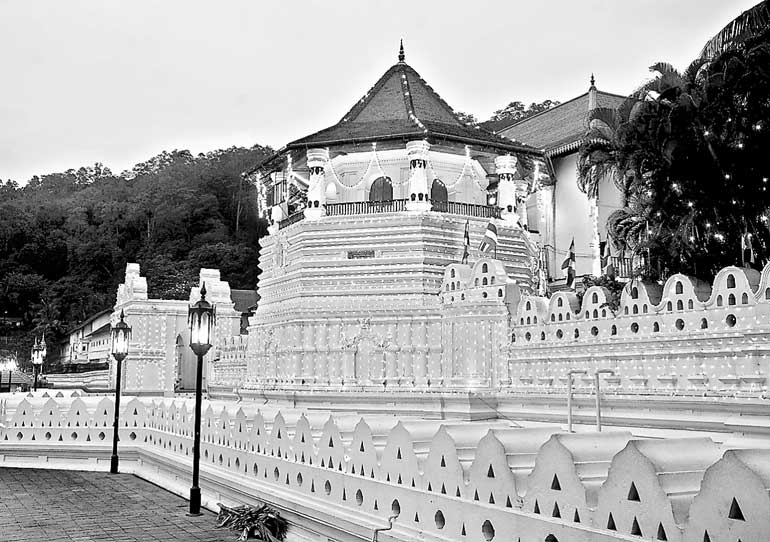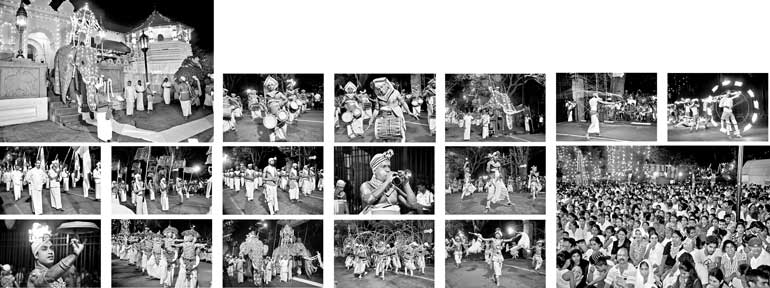Saturday Apr 26, 2025
Saturday Apr 26, 2025
Saturday, 12 August 2017 00:53 - - {{hitsCtrl.values.hits}}
 After several years I decided to watch the Rupavahini telecast of the Grand Finale – final night of the Kandy Randoli Perahera.
After several years I decided to watch the Rupavahini telecast of the Grand Finale – final night of the Kandy Randoli Perahera.
Though I could have linked the telecast to a bigger TV screen I preferred not to. I was quite happy seeing it on my laptop – the picture was clear, there were no interruptions or breakdowns, and the sound was good except for an occasional echo that did not last too long. And the commentary was done well with no unnecessary ‘alankaara katha’. Even the academic who supported the commentator (I couldn’t get their names) was to the point. He paid due recognition to the dance performers by identifying them by name.
I was prompted to see the telecast because of the pre-Perahera negative media reports, particularly raising questions whether enough elephants would be available this year, which in turn would affect the grandeur of the unique Esala Pageant held once a year.
In fact, I started counting the number of elephants. There were 34 in the Maligawa Perahera and possibly an equal number, if not more, in the Devala processions. Most of the animals belonged to temples. It was good to see that there were quite a number of young ones which is a good sign for the future.

There was concern about the one to carry the relic casket. Though the Nedungamuwe Aththa was mentioned as the possible ‘candidate’, its services had been obtained for the Kataragama Perahera which coincided with the Kandy Perahera and being well over 60 years it would have been too strenuous to move over to Kandy. The age is really against some of the seniors who were regulars for many years.
 Indi-Raja gifted by India carried the casket this year flanked by Myan-Raja and Buruma-Raja, both from Myanmar. Incidentally, it has been reported that a gifted elephant from Myanmar is on the way.
Indi-Raja gifted by India carried the casket this year flanked by Myan-Raja and Buruma-Raja, both from Myanmar. Incidentally, it has been reported that a gifted elephant from Myanmar is on the way.
To see this year’s elephants in brand new costumes was most welcome. They were not only colourful (blue was the dominant colour with some, including the Maligawa tusker, in light red), the designs were very attractive too.
It was encouraging to see a lot of youth among the dancers. A fine mix of the old and the young was seen confirming that traditional Kandyan dancing is not in danger of extinction or there is lack of interest. In the mix was an 87-year-old Pantheru dancer who had continuously taken part in the Perahera for 47 years – still quite vigorous and energetic.
Performing the tricky ‘raban circling’ was a family – father, sons and three grandsons, ensuring that the difficult art will continue for many more years. It was also interesting to see young boys performing the ‘gini bola’ – fire balls just after the ‘kasa karuvo’ – the whip crackers.
The professionalism displayed by all the dance troupes was proof of their discipline and keen interest.
One thing was clear. The Diyawadana Nilame, Pradeep Nilanga Dela’s leadership was evident. As the 19th Diyawadana Nilame he has acquired sufficient experience over the past 12 years (he first got elected in 2005) to keep improving the Esala Pageant making it an event worthwhile for anyone from long distances in any part of the world to come and witness.
Pix by Chanuka Kulasekara

Discover Kapruka, the leading online shopping platform in Sri Lanka, where you can conveniently send Gifts and Flowers to your loved ones for any event including Valentine ’s Day. Explore a wide range of popular Shopping Categories on Kapruka, including Toys, Groceries, Electronics, Birthday Cakes, Fruits, Chocolates, Flower Bouquets, Clothing, Watches, Lingerie, Gift Sets and Jewellery. Also if you’re interested in selling with Kapruka, Partner Central by Kapruka is the best solution to start with. Moreover, through Kapruka Global Shop, you can also enjoy the convenience of purchasing products from renowned platforms like Amazon and eBay and have them delivered to Sri Lanka.
Discover Kapruka, the leading online shopping platform in Sri Lanka, where you can conveniently send Gifts and Flowers to your loved ones for any event including Valentine ’s Day. Explore a wide range of popular Shopping Categories on Kapruka, including Toys, Groceries, Electronics, Birthday Cakes, Fruits, Chocolates, Flower Bouquets, Clothing, Watches, Lingerie, Gift Sets and Jewellery. Also if you’re interested in selling with Kapruka, Partner Central by Kapruka is the best solution to start with. Moreover, through Kapruka Global Shop, you can also enjoy the convenience of purchasing products from renowned platforms like Amazon and eBay and have them delivered to Sri Lanka.